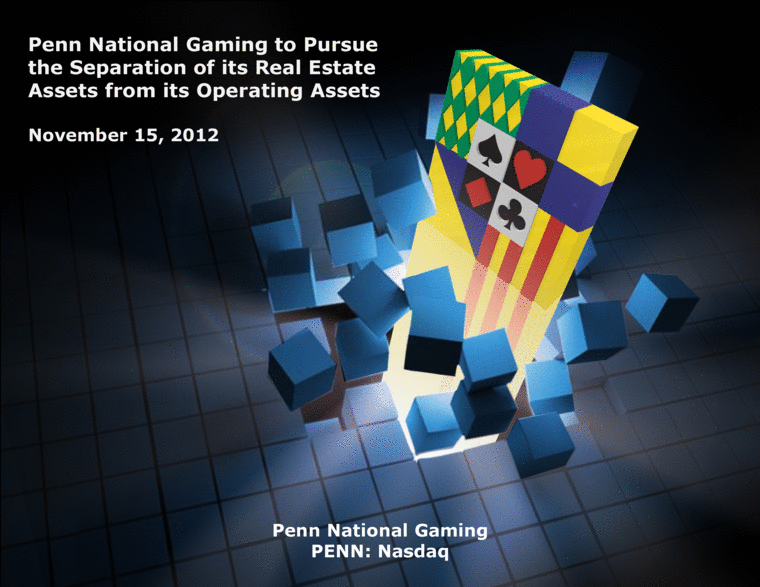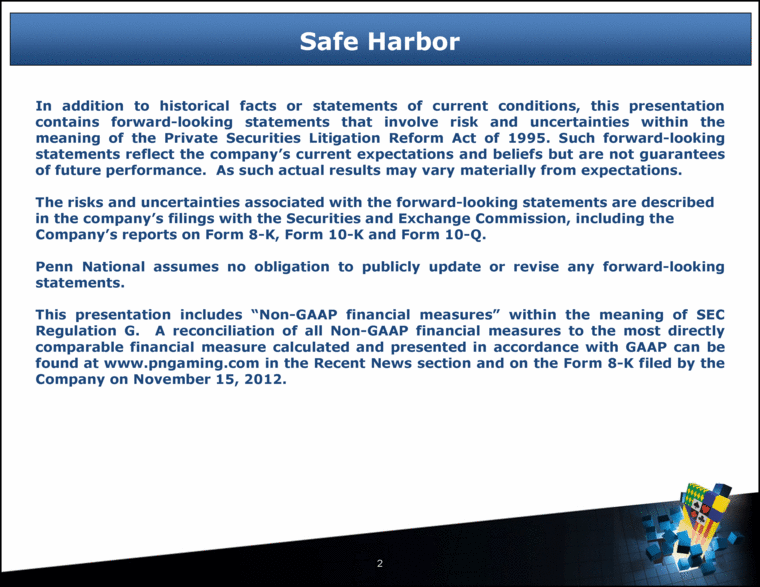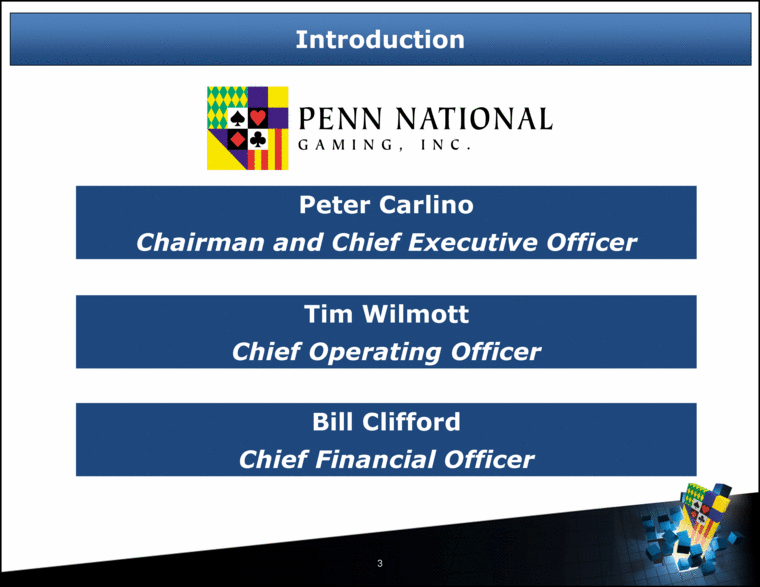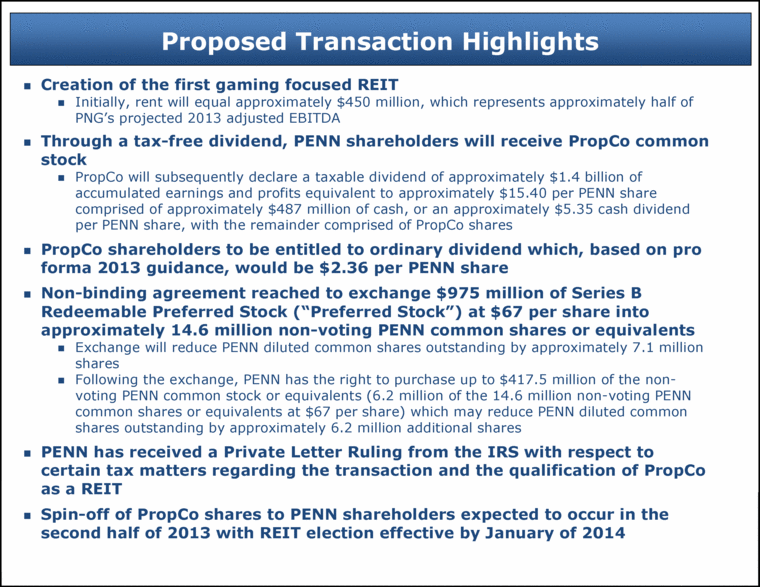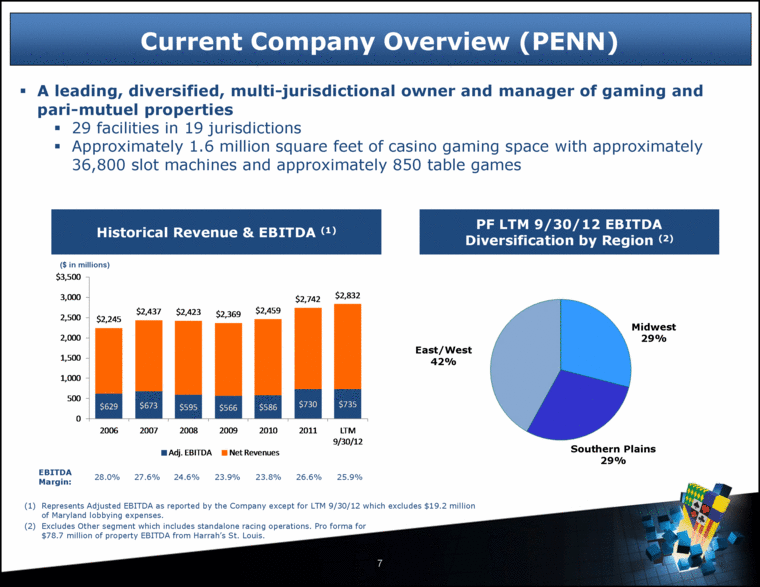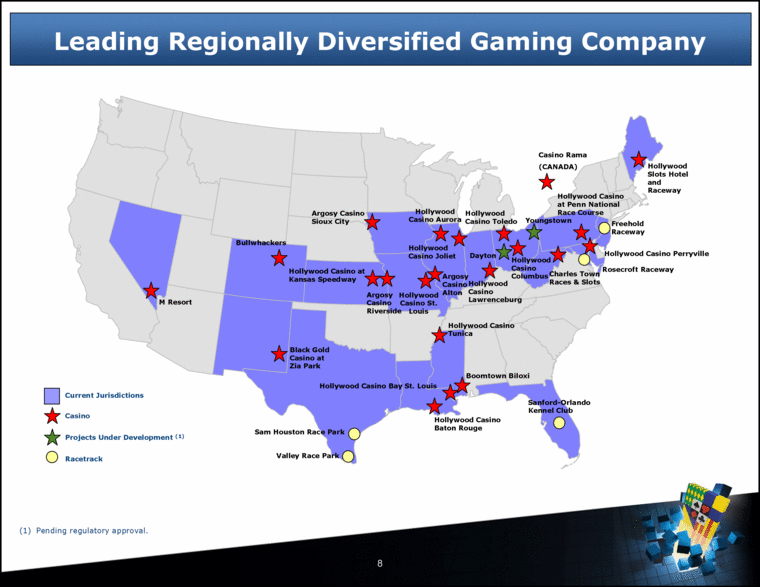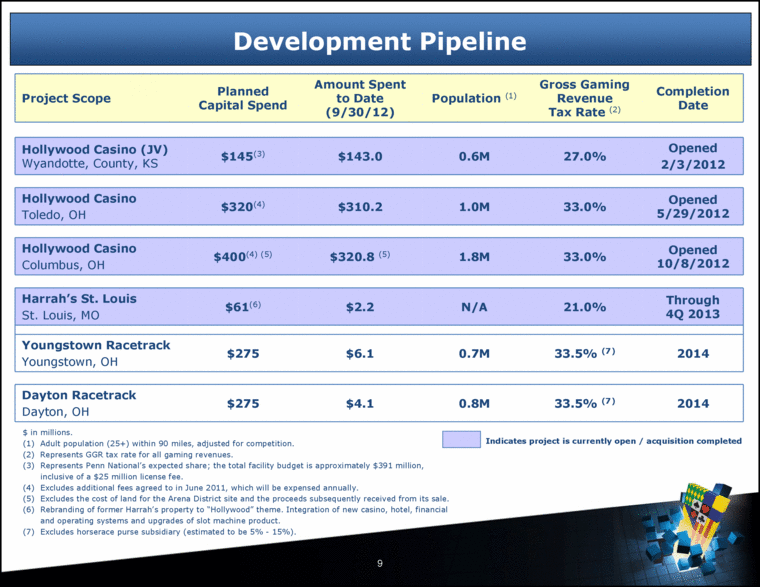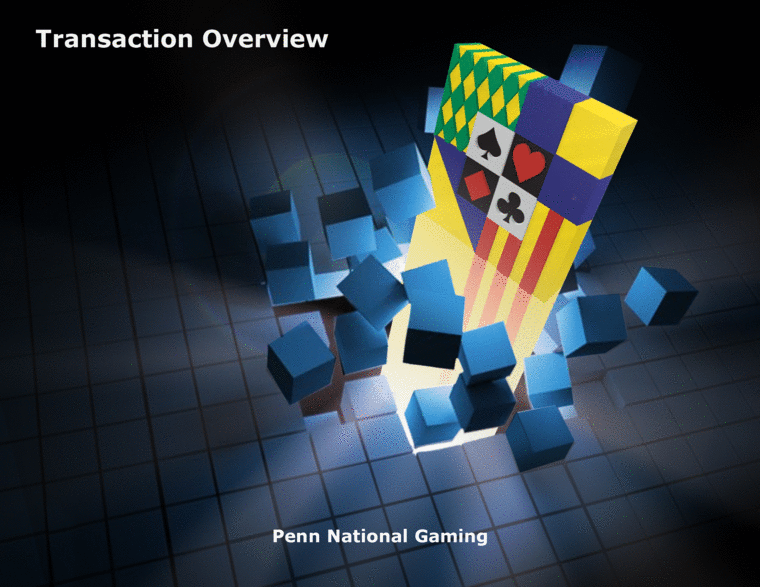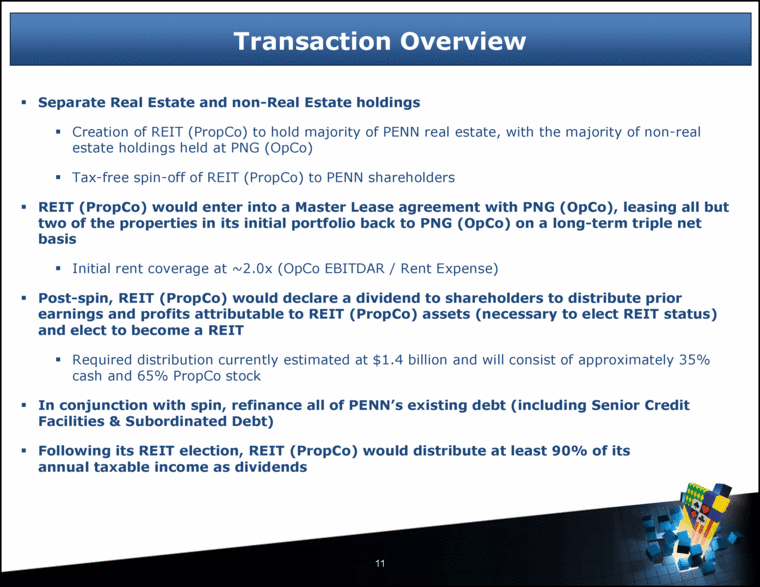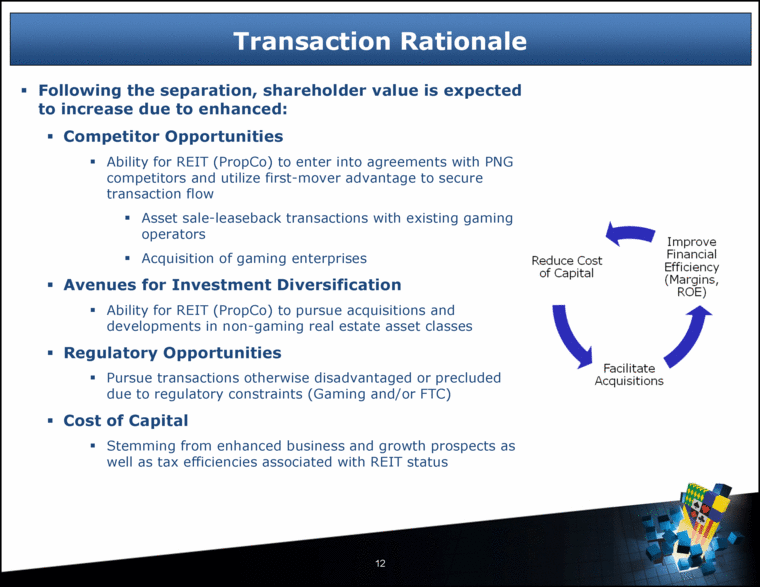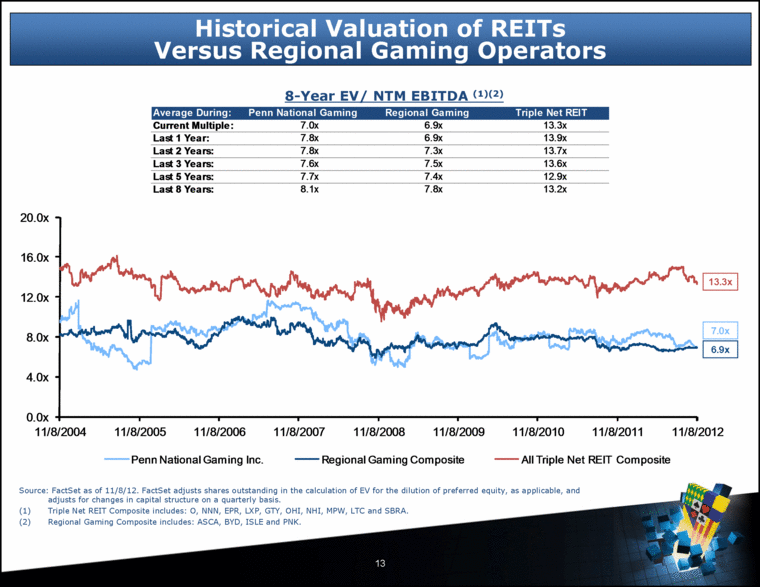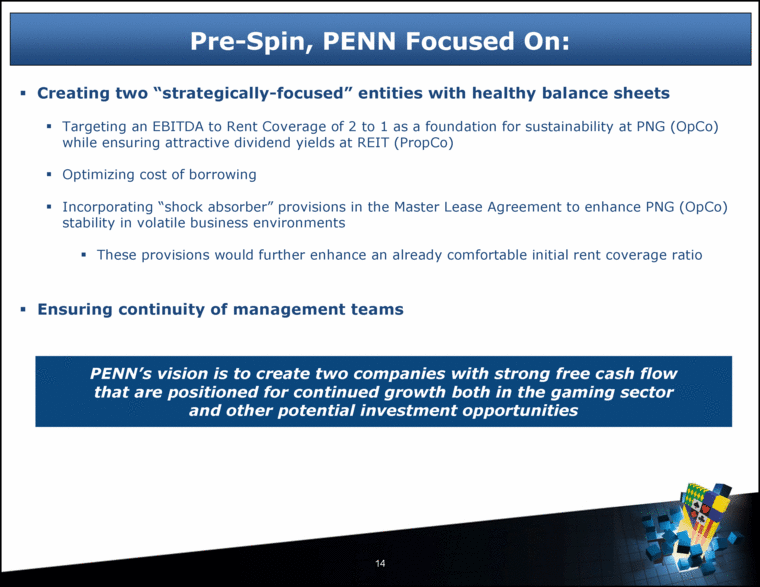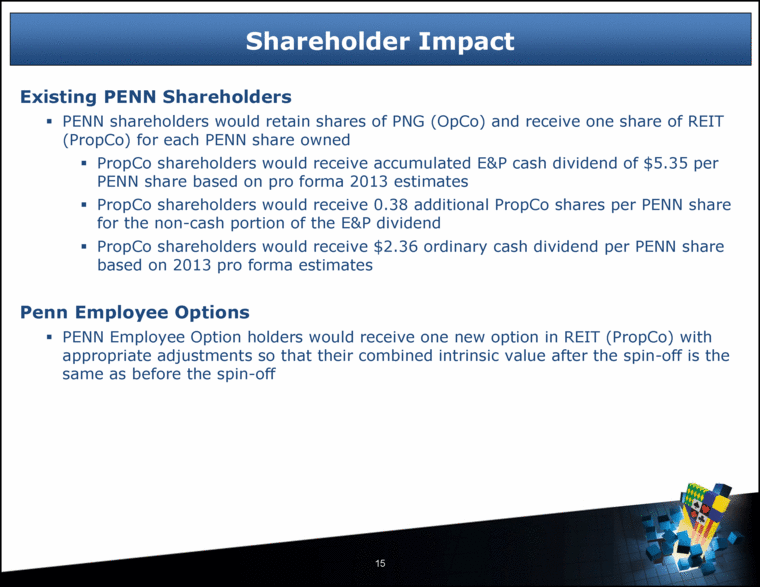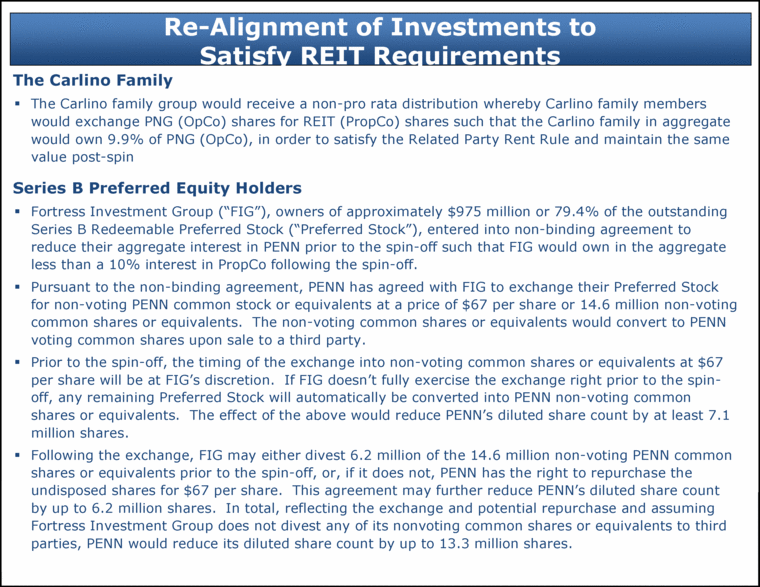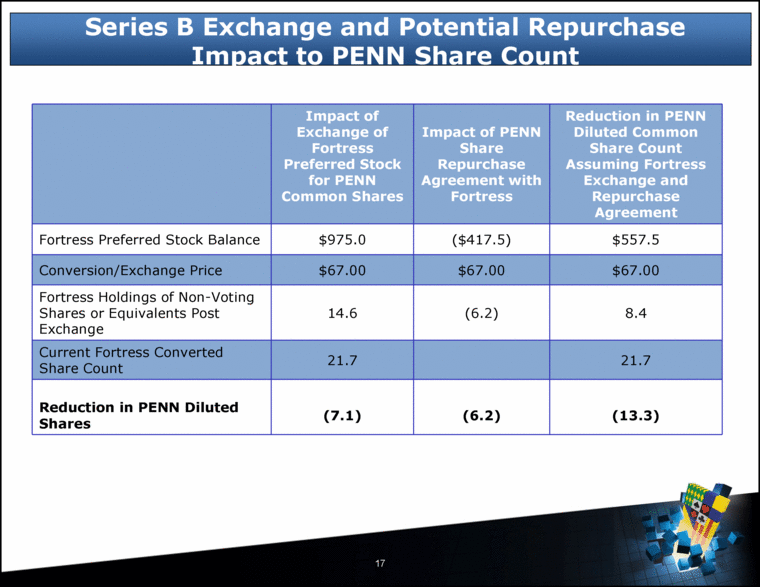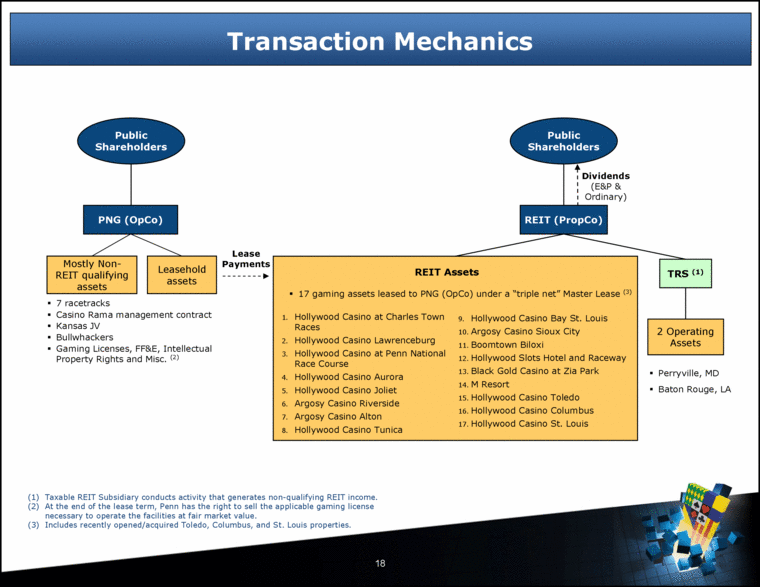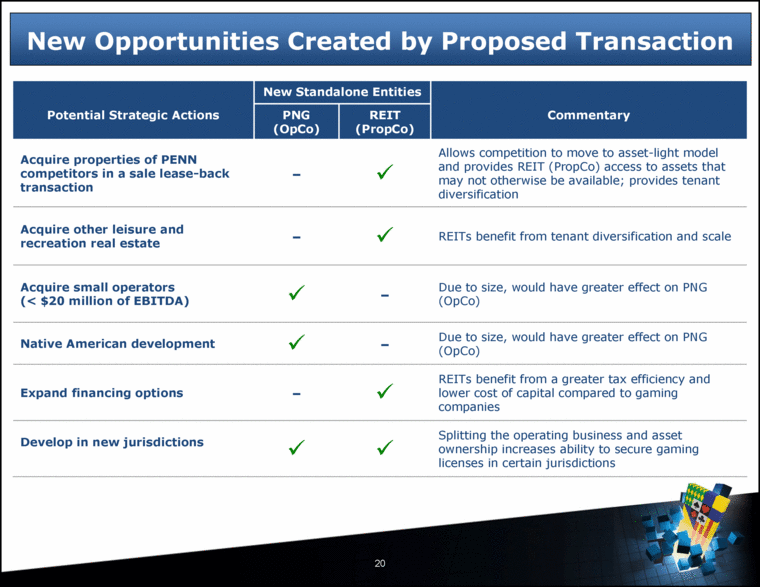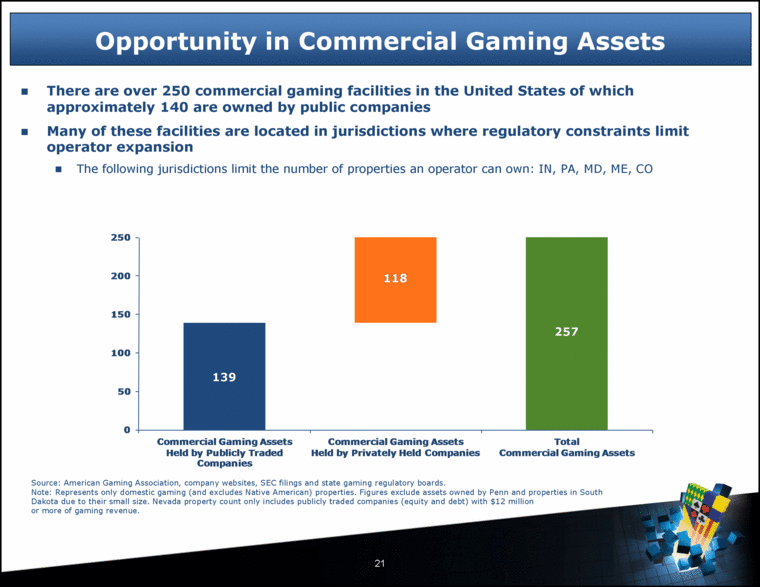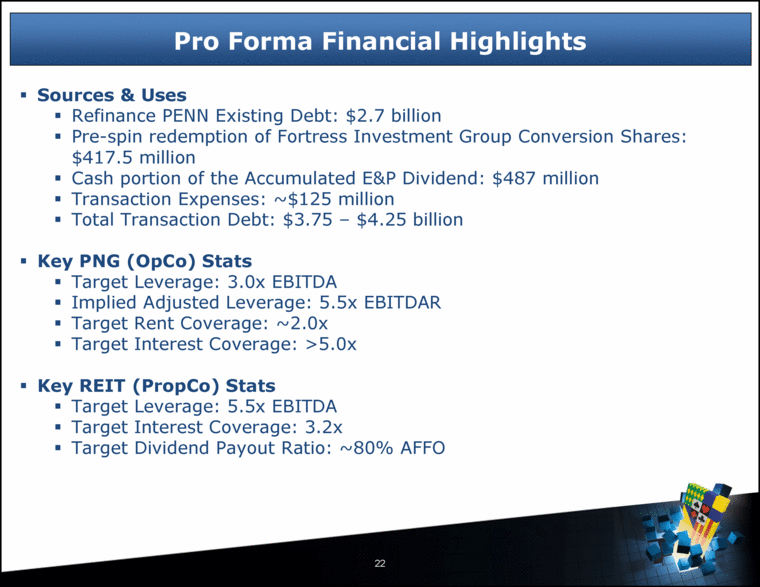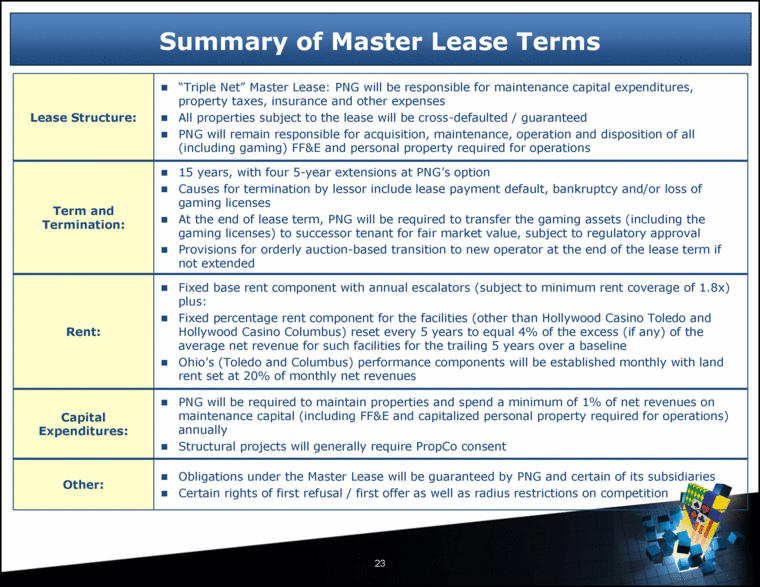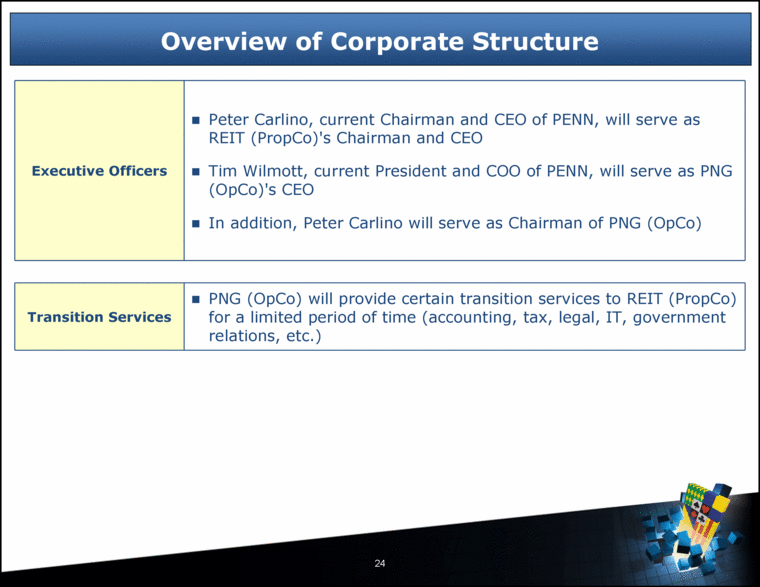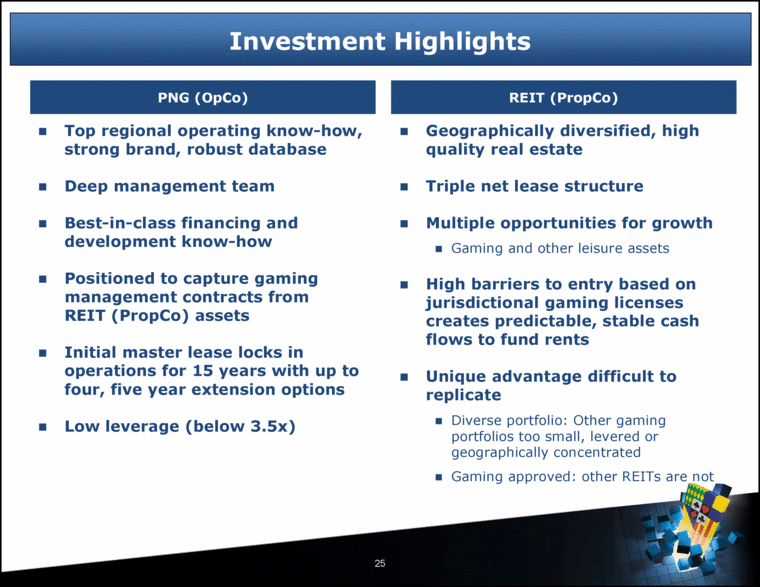Attached files
| file | filename |
|---|---|
| 8-K - 8-K - PENN NATIONAL GAMING INC | a12-27235_18k.htm |
| EX-99.1 - EX-99.1 - PENN NATIONAL GAMING INC | a12-27235_1ex99d1.htm |
Exhibit 99.2
|
|
1 Penn National Gaming PENN: Nasdaq Penn National Gaming to Pursue the Separation of its Real Estate Assets from its Operating Assets November 15, 2012 |
|
|
2 In addition to historical facts or statements of current conditions, this presentation contains forward-looking statements that involve risk and uncertainties within the meaning of the Private Securities Litigation Reform Act of 1995. Such forward-looking statements reflect the company’s current expectations and beliefs but are not guarantees of future performance. As such actual results may vary materially from expectations. The risks and uncertainties associated with the forward-looking statements are described in the company’s filings with the Securities and Exchange Commission, including the Company’s reports on Form 8-K, Form 10-K and Form 10-Q. Penn National assumes no obligation to publicly update or revise any forward-looking statements. This presentation includes “Non-GAAP financial measures” within the meaning of SEC Regulation G. A reconciliation of all Non-GAAP financial measures to the most directly comparable financial measure calculated and presented in accordance with GAAP can be found at www.pngaming.com in the Recent News section and on the Form 8-K filed by the Company on November 15, 2012. Safe Harbor |
|
|
3 Introduction Bill Clifford Chief Financial Officer Tim Wilmott Chief Operating Officer Peter Carlino Chairman and Chief Executive Officer |
|
|
4 Throughout this presentation: “PENN” refers to Penn National Gaming, Inc. (existing entity) “PropCo” refers to the proposed newly formed, publicly traded real estate investment trust (“REIT”) to be spun-off to PENN shareholders “PNG” or “OpCo” refers to the operating entity following the proposed spin-off of PropCo |
|
|
5 Creation of the first gaming focused REIT Initially, rent will equal approximately $450 million, which represents approximately half of PNG’s projected 2013 adjusted EBITDA Through a tax-free dividend, PENN shareholders will receive PropCo common stock PropCo will subsequently declare a taxable dividend of approximately $1.4 billion of accumulated earnings and profits equivalent to approximately $15.40 per PENN share comprised of approximately $487 million of cash, or an approximately $5.35 cash dividend per PENN share, with the remainder comprised of PropCo shares PropCo shareholders to be entitled to ordinary dividend which, based on pro forma 2013 guidance, would be $2.36 per PENN share Non-binding agreement reached to exchange $975 million of Series B Redeemable Preferred Stock (“Preferred Stock”) at $67 per share into approximately 14.6 million non-voting PENN common shares or equivalents Exchange will reduce PENN diluted common shares outstanding by approximately 7.1 million shares Following the exchange, PENN has the right to purchase up to $417.5 million of the non-voting PENN common stock or equivalents (6.2 million of the 14.6 million non-voting PENN common shares or equivalents at $67 per share) which may reduce PENN diluted common shares outstanding by approximately 6.2 million additional shares PENN has received a Private Letter Ruling from the IRS with respect to certain tax matters regarding the transaction and the qualification of PropCo as a REIT Spin-off of PropCo shares to PENN shareholders expected to occur in the second half of 2013 with REIT election effective by January of 2014 Proposed Transaction Highlights |
|
|
6 Leading Diversified Regional Gaming Company with Regional Focus 29 properties in 19 jurisdictions, including recently opened properties in Toledo and Columbus and the recently completed acquisition of Harrah’s St. Louis PENN’s regional markets have outperformed destination gaming markets, especially in periods of weakness in the economy LTM 9/30/12 Net Revenue of $2.8 billion and Adjusted EBITDA of $735 million (1) PF for the acquisition of Harrah’s St. Louis, LTM 9/30/12 Adjusted EBITDA of $813 million (2) Diversified Adjusted EBITDA composition Disciplined, Market-Tested Management Team Industry leading property operating margins Leading development and acquisition track record Prudent Capital Spend / Robust Development Pipeline / Ongoing Margin Focus Disciplined maintenance capex in existing properties Project capex calibrated to market size, tax rate and cash return Near-term growth projects: Youngstown and Dayton, OH racetracks Several options for future growth (MA, FL, TX) Current Company Overview (PENN) Excludes $19.2 million of Maryland lobbying expenses. Includes $78.7 million of property EBITDA from Harrah’s St. Louis. |
|
|
7 Current Company Overview (PENN) A leading, diversified, multi-jurisdictional owner and manager of gaming and pari-mutuel properties 29 facilities in 19 jurisdictions Approximately 1.6 million square feet of casino gaming space with approximately 36,800 slot machines and approximately 850 table games Historical Revenue & EBITDA (1) PF LTM 9/30/12 EBITDA Diversification by Region (2) ($ in millions) EBITDA Margin: 28.0% 27.6% 24.6% 23.9% 23.8% 26.6% 25.9% Represents Adjusted EBITDA as reported by the Company except for LTM 9/30/12 which excludes $19.2 million of Maryland lobbying expenses. Excludes Other segment which includes standalone racing operations. Pro forma for $78.7 million of property EBITDA from Harrah’s St. Louis. East/West 42% Midwest 29% Southern Plains 29% $629 $673 $595 $566 $586 $730 $735 $2,245 $2,437 $2,423 $2,369 $2,459 $2,742 $2,832 0 500 1,000 1,500 2,000 2,500 3,000 $3,500 2006 2007 2008 2009 2010 2011 LTM 9/30/12 Adj. EBITDA Net Revenues |
|
|
8 Youngstown Leading Regionally Diversified Gaming Company Black Gold Casino at Zia Park Argosy Casino Sioux City Hollywood Casino Aurora Hollywood Casino Joliet Argosy Casino Alton Hollywood Casino Bay St. Louis Hollywood Casino Baton Rouge Boomtown Biloxi Sanford-Orlando Kennel Club Charles Town Races & Slots Hollywood Casino Lawrenceburg Hollywood Casino Toledo Casino Rama (CANADA) Hollywood Casino at Penn National Race Course Freehold Raceway Hollywood Slots Hotel and Raceway Argosy Casino Riverside Hollywood Casino Tunica Bullwhackers Racetrack Casino Current Jurisdictions Rosecroft Raceway Dayton Hollywood Casino Perryville Sam Houston Race Park Valley Race Park Hollywood Casino Columbus Hollywood Casino at Kansas Speedway Projects Under Development (1) M Resort (1) Pending regulatory approval. Hollywood Casino St. Louis |
|
|
9 Development Pipeline $ in millions. (1) Adult population (25+) within 90 miles, adjusted for competition. (2) Represents GGR tax rate for all gaming revenues. Represents Penn National’s expected share; the total facility budget is approximately $391 million, inclusive of a $25 million license fee. Excludes additional fees agreed to in June 2011, which will be expensed annually. Excludes the cost of land for the Arena District site and the proceeds subsequently received from its sale. Rebranding of former Harrah’s property to “Hollywood” theme. Integration of new casino, hotel, financial and operating systems and upgrades of slot machine product. Excludes horserace purse subsidiary (estimated to be 5% - 15%). Project Scope Planned Capital Spend Amount Spent to Date (9/30/12) Population (1) Gross Gaming Revenue Tax Rate (2) Completion Date Hollywood Casino (JV) Wyandotte, County, KS $145(3) $143.0 0.6M 27.0% Opened 2/3/2012 Hollywood Casino Toledo, OH $320(4) $310.2 1.0M 33.0% Opened 5/29/2012 Hollywood Casino Columbus, OH $400(4) (5) $320.8 (5) 1.8M 33.0% Opened 10/8/2012 Harrah’s St. Louis St. Louis, MO $61(6) $2.2 N/A 21.0% Through 4Q 2013 Youngstown Racetrack Youngstown, OH $275 $6.1 0.7M 33.5% (7) 2014 Dayton Racetrack Dayton, OH $275 $4.1 0.8M 33.5% (7) 2014 Indicates project is currently open / acquisition completed |
|
|
10 Penn National Gaming Transaction Overview |
|
|
11 Transaction Overview Separate Real Estate and non-Real Estate holdings Creation of REIT (PropCo) to hold majority of PENN real estate, with the majority of non-real estate holdings held at PNG (OpCo) Tax-free spin-off of REIT (PropCo) to PENN shareholders REIT (PropCo) would enter into a Master Lease agreement with PNG (OpCo), leasing all but two of the properties in its initial portfolio back to PNG (OpCo) on a long-term triple net basis Initial rent coverage at ~2.0x (OpCo EBITDAR / Rent Expense) Post-spin, REIT (PropCo) would declare a dividend to shareholders to distribute prior earnings and profits attributable to REIT (PropCo) assets (necessary to elect REIT status) and elect to become a REIT Required distribution currently estimated at $1.4 billion and will consist of approximately 35% cash and 65% PropCo stock In conjunction with spin, refinance all of PENN’s existing debt (including Senior Credit Facilities & Subordinated Debt) Following its REIT election, REIT (PropCo) would distribute at least 90% of its annual taxable income as dividends |
|
|
Following the separation, shareholder value is expected to increase due to enhanced: Competitor Opportunities Ability for REIT (PropCo) to enter into agreements with PNG competitors and utilize first-mover advantage to secure transaction flow Asset sale-leaseback transactions with existing gaming operators Acquisition of gaming enterprises Avenues for Investment Diversification Ability for REIT (PropCo) to pursue acquisitions and developments in non-gaming real estate asset classes Regulatory Opportunities Pursue transactions otherwise disadvantaged or precluded due to regulatory constraints (Gaming and/or FTC) Cost of Capital Stemming from enhanced business and growth prospects as well as tax efficiencies associated with REIT status 12 Transaction Rationale |
|
|
8-Year EV/ NTM EBITDA (1)(2) 15 Historical Valuation of REITs Versus Regional Gaming Operators Source: FactSet as of 11/8/12. FactSet adjusts shares outstanding in the calculation of EV for the dilution of preferred equity, as applicable, and adjusts for changes in capital structure on a quarterly basis. Triple Net REIT Composite includes: O, NNN, EPR, LXP, GTY, OHI, NHI, MPW, LTC and SBRA. Regional Gaming Composite includes: ASCA, BYD, ISLE and PNK. 13 7.0x 6.9x 13.3x 0.0x 4.0x 8.0x 12.0x 16.0x 20.0x 11/8/2004 11/8/2005 11/8/2006 11/8/2007 11/8/2008 11/8/2009 11/8/2010 11/8/2011 11/8/2012 Penn National Gaming Inc. Regional Gaming Composite All Triple Net REIT Composite Average During: Penn National Gaming Regional Gaming Triple Net REIT Current Multiple: 7.0x 6.9x 13.3x Last 1 Year: 7.8x 6.9x 13.9x Last 2 Years: 7.8x 7.3x 13.7x Last 3 Years: 7.6x 7.5x 13.6x Last 5 Years: 7.7x 7.4x 12.9x Last 8 Years: 8.1x 7.8x 13.2x |
|
|
14 Pre-Spin, PENN Focused On: Creating two “strategically-focused” entities with healthy balance sheets Targeting an EBITDA to Rent Coverage of 2 to 1 as a foundation for sustainability at PNG (OpCo) while ensuring attractive dividend yields at REIT (PropCo) Optimizing cost of borrowing Incorporating “shock absorber” provisions in the Master Lease Agreement to enhance PNG (OpCo) stability in volatile business environments These provisions would further enhance an already comfortable initial rent coverage ratio Ensuring continuity of management teams PENN’s vision is to create two companies with strong free cash flow that are positioned for continued growth both in the gaming sector and other potential investment opportunities |
|
|
15 Shareholder Impact Existing PENN Shareholders PENN shareholders would retain shares of PNG (OpCo) and receive one share of REIT (PropCo) for each PENN share owned PropCo shareholders would receive accumulated E&P cash dividend of $5.35 per PENN share based on pro forma 2013 estimates PropCo shareholders would receive 0.38 additional PropCo shares per PENN share for the non-cash portion of the E&P dividend PropCo shareholders would receive $2.36 ordinary cash dividend per PENN share based on 2013 pro forma estimates Penn Employee Options PENN Employee Option holders would receive one new option in REIT (PropCo) with appropriate adjustments so that their combined intrinsic value after the spin-off is the same as before the spin-off |
|
|
16 Re-Alignment of Investments to Satisfy REIT Requirements The Carlino Family The Carlino family group would receive a non-pro rata distribution whereby Carlino family members would exchange PNG (OpCo) shares for REIT (PropCo) shares such that the Carlino family in aggregate would own 9.9% of PNG (OpCo), in order to satisfy the Related Party Rent Rule and maintain the same value post-spin Series B Preferred Equity Holders Fortress Investment Group (“FIG”), owners of approximately $975 million or 79.4% of the outstanding Series B Redeemable Preferred Stock (“Preferred Stock”), entered into non-binding agreement to reduce their aggregate interest in PENN prior to the spin-off such that FIG would own in the aggregate less than a 10% interest in PropCo following the spin-off. Pursuant to the non-binding agreement, PENN has agreed with FIG to exchange their Preferred Stock for non-voting PENN common stock or equivalents at a price of $67 per share or 14.6 million non-voting common shares or equivalents. The non-voting common shares or equivalents would convert to PENN voting common shares upon sale to a third party. Prior to the spin-off, the timing of the exchange into non-voting common shares or equivalents at $67 per share will be at FIG’s discretion. If FIG doesn’t fully exercise the exchange right prior to the spin-off, any remaining Preferred Stock will automatically be converted into PENN non-voting common shares or equivalents. The effect of the above would reduce PENN’s diluted share count by at least 7.1 million shares. Following the exchange, FIG may either divest 6.2 million of the 14.6 million non-voting PENN common shares or equivalents prior to the spin-off, or, if it does not, PENN has the right to repurchase the undisposed shares for $67 per share. This agreement may further reduce PENN’s diluted share count by up to 6.2 million shares. In total, reflecting the exchange and potential repurchase and assuming Fortress Investment Group does not divest any of its nonvoting common shares or equivalents to third parties, PENN would reduce its diluted share count by up to 13.3 million shares. |
|
|
17 Series B Exchange and Potential Repurchase Impact to PENN Share Count Impact of Exchange of Fortress Preferred Stock for PENN Common Shares Impact of PENN Share Repurchase Agreement with Fortress Reduction in PENN Diluted Common Share Count Assuming Fortress Exchange and Repurchase Agreement Fortress Preferred Stock Balance $975.0 ($417.5) $557.5 Conversion/Exchange Price $67.00 $67.00 $67.00 Fortress Holdings of Non-Voting Shares or Equivalents Post Exchange 14.6 (6.2) 8.4 Current Fortress Converted Share Count 21.7 21.7 Reduction in PENN Diluted Shares (7.1) (6.2) (13.3) |
|
|
18 Transaction Mechanics (1) Taxable REIT Subsidiary conducts activity that generates non-qualifying REIT income. At the end of the lease term, Penn has the right to sell the applicable gaming license necessary to operate the facilities at fair market value. Includes recently opened/acquired Toledo, Columbus, and St. Louis properties. Public Shareholders REIT (PropCo) PNG (OpCo) Dividends (E&P & Ordinary) Lease Payments Mostly Non-REIT qualifying assets 7 racetracks Casino Rama management contract Kansas JV Bullwhackers Gaming Licenses, FF&E, Intellectual Property Rights and Misc. (2) REIT Assets 17 gaming assets leased to PNG (OpCo) under a “triple net” Master Lease (3) TRS (1) 2 Operating Assets Perryville, MD Baton Rouge, LA Public Shareholders Hollywood Casino at Charles Town Races Hollywood Casino Lawrenceburg Hollywood Casino at Penn National Race Course Hollywood Casino Aurora Hollywood Casino Joliet Argosy Casino Riverside Argosy Casino Alton Hollywood Casino Tunica Hollywood Casino Bay St. Louis Argosy Casino Sioux City Boomtown Biloxi Hollywood Slots Hotel and Raceway Black Gold Casino at Zia Park M Resort Hollywood Casino Toledo Hollywood Casino Columbus Hollywood Casino St. Louis Leasehold assets |
|
|
19 Key Next Steps PENN has performed over two years of diligence and has had ongoing discussions with the IRS Next steps: Q2 2013 Begin Financing Transactions Q2 2013 Prepare spin-off agreements and SEC filings (including pro forma financial statements for each company) Q2 2013 File Form S-11 Q4 2013 Distribution made after Form S-11 declared effective and Complete Regulatory Process Q4 2013 OpCo completes tax-free spin of PropCo Q1 2014 PropCo to purge E&P and make REIT election |
|
|
20 New Opportunities Created by Proposed Transaction New Standalone Entities Potential Strategic Actions PNG (OpCo) REIT (PropCo) Commentary Acquire properties of PENN competitors in a sale lease-back transaction - ü Allows competition to move to asset-light model and provides REIT (PropCo) access to assets that may not otherwise be available; provides tenant diversification Acquire other leisure and recreation real estate - ü REITs benefit from tenant diversification and scale Acquire small operators (< $20 million of EBITDA) ü - Due to size, would have greater effect on PNG (OpCo) Native American development ü - Due to size, would have greater effect on PNG (OpCo) Expand financing options - ü REITs benefit from a greater tax efficiency and lower cost of capital compared to gaming companies Develop in new jurisdictions ü ü Splitting the operating business and asset ownership increases ability to secure gaming licenses in certain jurisdictions |
|
|
21 Opportunity in Commercial Gaming Assets There are over 250 commercial gaming facilities in the United States of which approximately 140 are owned by public companies Many of these facilities are located in jurisdictions where regulatory constraints limit operator expansion The following jurisdictions limit the number of properties an operator can own: IN, PA, MD, ME, CO Source: American Gaming Association, company websites, SEC filings and state gaming regulatory boards. Note: Represents only domestic gaming (and excludes Native American) properties. Figures exclude assets owned by Penn and properties in South Dakota due to their small size. Nevada property count only includes publicly traded companies (equity and debt) with $12 million or more of gaming revenue. 139 118 257 0 50 100 150 200 250 Commercial Gaming Assets Held by Publicly Traded Companies Commercial Gaming Assets Held by Privately Held Companies Total Commercial Gaming Assets |
|
|
22 Pro Forma Financial Highlights Sources & Uses Refinance PENN Existing Debt: $2.7 billion Pre-spin redemption of Fortress Investment Group Conversion Shares: $417.5 million Cash portion of the Accumulated E&P Dividend: $487 million Transaction Expenses: ~$125 million Total Transaction Debt: $3.75 – $4.25 billion Key PNG (OpCo) Stats Target Leverage: 3.0x EBITDA Implied Adjusted Leverage: 5.5x EBITDAR Target Rent Coverage: ~2.0x Target Interest Coverage: >5.0x Key REIT (PropCo) Stats Target Leverage: 5.5x EBITDA Target Interest Coverage: 3.2x Target Dividend Payout Ratio: ~80% AFFO |
|
|
23 Summary of Master Lease Terms Lease Structure: “Triple Net” Master Lease: PNG will be responsible for maintenance capital expenditures, property taxes, insurance and other expenses All properties subject to the lease will be cross-defaulted / guaranteed PNG will remain responsible for acquisition, maintenance, operation and disposition of all (including gaming) FF&E and personal property required for operations Term and Termination: 15 years, with four 5-year extensions at PNG’s option Causes for termination by lessor include lease payment default, bankruptcy and/or loss of gaming licenses At the end of lease term, PNG will be required to transfer the gaming assets (including the gaming licenses) to successor tenant for fair market value, subject to regulatory approval Provisions for orderly auction-based transition to new operator at the end of the lease term if not extended Rent: Fixed base rent component with annual escalators (subject to minimum rent coverage of 1.8x) plus: Fixed percentage rent component for the facilities (other than Hollywood Casino Toledo and Hollywood Casino Columbus) reset every 5 years to equal 4% of the excess (if any) of the average net revenue for such facilities for the trailing 5 years over a baseline Ohio’s (Toledo and Columbus) performance components will be established monthly with land rent set at 20% of monthly net revenues Capital Expenditures: PNG will be required to maintain properties and spend a minimum of 1% of net revenues on maintenance capital (including FF&E and capitalized personal property required for operations) annually Structural projects will generally require PropCo consent Other: Obligations under the Master Lease will be guaranteed by PNG and certain of its subsidiaries Certain rights of first refusal / first offer as well as radius restrictions on competition |
|
|
24 Overview of Corporate Structure Executive Officers Peter Carlino, current Chairman and CEO of PENN, will serve as REIT (PropCo)'s Chairman and CEO Tim Wilmott, current President and COO of PENN, will serve as PNG (OpCo)'s CEO In addition, Peter Carlino will serve as Chairman of PNG (OpCo) Transition Services PNG (OpCo) will provide certain transition services to REIT (PropCo) for a limited period of time (accounting, tax, legal, IT, government relations, etc.) |
|
|
25 Investment Highlights REIT (PropCo) PNG (OpCo) Top regional operating know-how, strong brand, robust database Deep management team Best-in-class financing and development know-how Positioned to capture gaming management contracts from REIT (PropCo) assets Initial master lease locks in operations for 15 years with up to four, five year extension options Low leverage (below 3.5x) Geographically diversified, high quality real estate Triple net lease structure Multiple opportunities for growth Gaming and other leisure assets High barriers to entry based on jurisdictional gaming licenses creates predictable, stable cash flows to fund rents Unique advantage difficult to replicate Diverse portfolio: Other gaming portfolios too small, levered or geographically concentrated Gaming approved: other REITs are not |
|
|
Stable Performance Through Economic Cycles 26 Assuming the worst cumulative EBITDA decline (uniformly across all properties) observed to date immediately post-transaction, the rent coverage would decline to 1.6x Note: Same-store financials exclude revenue and EBITDA from racing operations, joint ventures, and corporate overhead. Same-store growth excludes properties without a full-year of operations in the previous year. (1) Excludes Hollywood Casino Shreveport (sold in 2004) from same-store growth calculations. ($ in millions) # of Properties 5 6 9 9 14 14 16 16 16 17 18 Sales Growth 43% 21% 17% 12% (1%) 4% 6% (10%) (2%) 2% 4% Same-Store EBITDA Growth 44% 21% 23% 18% 11% 7% 5% (13%) (6%) 5% 14% ? SS EBITDA / ? SS Sales 27% 24% 35% 40% NA 57% 24% 39% 76% 56% 101% $112 $141 $254 $283 $373 $629 $673 $595 $566 $586 $730 $517 $656 $1,163 $1,140 $1,369 $2,245 $2,437 $2,423 $2,369 $2,459 $2,742 22% 22% 22% 25% 27% 28% 28% 25% 24% 24% 27% 0% 10% 20% 30% 40% 50% 60% $0 $500 $1,000 $1,500 $2,000 $2,500 $3,000 2001 2002 2003 2004 2005 2006 2007 2008 2009 2010 2011 Total Revenue Total Revenues EBITDA Margin 1 1 |
|
|
27 Impact on Preferred Stock – Detailed Calculation (1) Remaining Series B Preferred Share Holders would only receive common stock of REIT (PropCo) per the calculation above; they would receive any preferred equity interest in PNG (OpCo). Calculation of REIT (PropCo) Common Shares Issued to Remaining PENN Preferred Stock Holders (1) Current Liquidation Preference $253mm Current Ceiling Price $67.00 Number of Shares Issued to Preferred Stock Holders N = $253mm/$67.00 Assumed Value of REIT (PropCo) Share at Spin-off S Before required E&P distribution Value of REIT (PropCo) Shares Issued to Series B Holders N*S Calculation of Post-spin PNG Preferred Stock Liquidation Preference and Adjusted Ceiling and Floor Prices (1) Current Liquidation Preference $253mm Value of REIT (PropCo) Shares Issued to Preferred Stock Holders N*S Preferred Stock Liquidation Preference - Post-spin Y = $253mm - N*S Adjusted Post-spin Ceiling Price $67.00 - S Adjusted Post-spin Ceiling Price $45.00 - S Before required E&P distribution |
|
|
28 Definitions and Reconciliation of Non-GAAP Measures to GAAP Adjusted EBITDA, or earnings before interest, taxes, stock compensation, insurance recoveries and deductible charges, depreciation and amortization, gain or loss on disposal of assets, and other income or expenses, and inclusive of gain or loss from unconsolidated affiliates, is not a measure of performance or liquidity calculated in accordance with GAAP Adjusted EBITDA information is presented as a supplemental disclosure, as management believes that it is a widely used measure of performance in the gaming industry. In addition, management uses adjusted EBITDA as the primary measure of the operating performance of its segments, including the evaluation of operating personnel. Adjusted EBITDA should not be construed as an alternative to operating income, as an indicator of the Company's operating performance, as an alternative to cash flows from operating activities, as a measure of liquidity, or as any other measure of performance determined in accordance with GAAP. The Company has significant uses of cash flows, including capital expenditures, interest payments, taxes and debt principal repayments, which are not reflected in adjusted EBITDA. It should also be noted that other gaming companies that report adjusted EBITDA information may calculate adjusted EBITDA in a different manner than the Company. Adjusted EBITDA is presented as a supplemental disclosure, as management believes that it is a principal basis for the valuation of gaming companies, as this measure is considered by many to be a better indicator of the Company’s operating results than diluted net income (loss) per GAAP. A reconciliation of the Company’s adjusted EBITDA to net income (loss) per GAAP, as well as the Company’s adjusted EBITDA to income (loss) from operations per GAAP, is included in the financial schedules accompanying today’s news announcement and is available on the Company’s website and as an exhibit to the Form 8-K filed by the Company on November 15, 2012. Adjusted EBITDAR is adjusted EBITDA less rent expense Funds From Operations (“FFO”) is equal to net income, excluding gains or losses from sales of property, adding back depreciation and stock compensation expense FFO is defined by NAREIT (the National Association of Real Estate Investment Trusts, the trade organization for REITs) as “the most commonly accepted and reported measure of REIT operating performance.” Adjusted Funds From Operations (“AFFO”) is defined as FFO less maintenance capex. A reconciliation of FFO and AFFO to net income (loss) per GAAP is included in the financial schedules accompanying today’s news announcement and is available on the Company’s website and as an exhibit to the Form 8-K filed by the Company on November 15, 2012. Notwithstanding the foregoing, PropCo’s measures of adjusted EBITDA, adjusted EBITDAR, FFO and AFFO may not be comparable to similarly titled measures used by other companies |

